Bulletin – June 2011 Trends in Labour Supply
- Download the article 300KB
Abstract
The labour force has grown strongly since the mid 2000s due to both a rising participation rate and faster population growth. The increase in participation has been greatest for females and older persons, driven by a range of social and economic factors. At the same time, average hours worked have declined as many of these additional workers are working part time. The rise in population growth has mostly reflected higher immigration, with a larger intake of skilled workers and students adding to the labour supply.
Introduction
The labour force includes all employed persons and those actively looking for work, and has grown at an average annualised rate of 2½ per cent since 2005. This is faster than its average pace over the previous 25 years, and is the result of both strong population growth and a rising participation rate (the labour force as a share of the population aged 15 and over) (Graph 1).
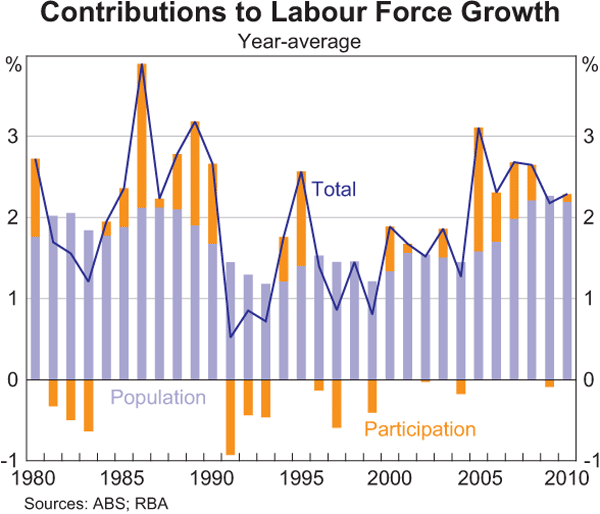
Since 1980, the total participation rate has risen by 5 percentage points, from 61 to 66 per cent (Graph 2). When labour force participation is broken down by age group and gender, it is clear that this has been driven by females and older workers. Since 1980, the participation rate of females aged 25 to 54 has increased by around 20 percentage points, while the participation rate of women aged 55 to 64 has risen by a remarkable 35 percentage points (Graph 3). Male participation declined from 1980 to 2000, but since then the participation rate of males aged 25 to 54 has increased slightly, and the participation rate of males aged 55 to 64 has risen by over 10 percentage points.
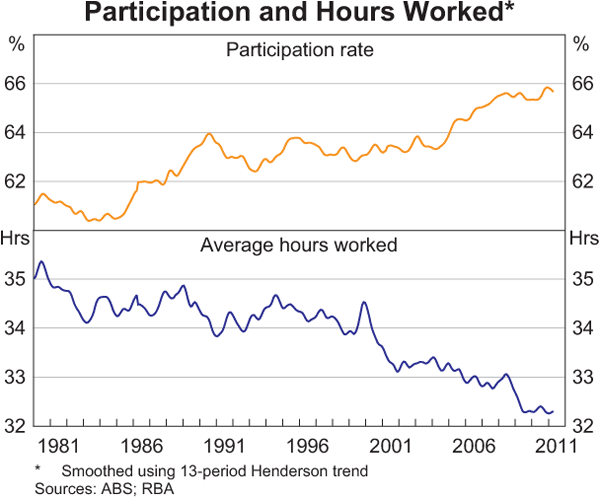
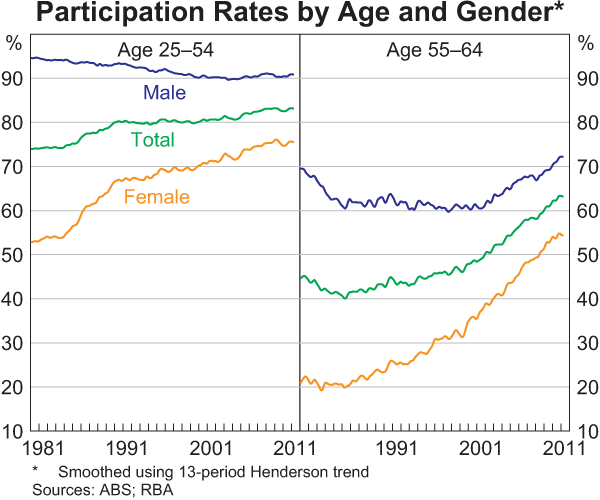
While the participation rate has been rising, average hours worked by employed persons have fallen from 35 hours per week in 1980 to just over 32 hours per week in 2010, with the decline mainly occurring over the past decade (Graph 2). The fall in average hours worked is related to the factors underlying the rise in the participation rate, with women and older workers more likely to work part time. It also reflects a fall in the share of people working long hours over recent years.
The other important determinant of labour supply is the size of the working age population, which has grown at an annualised rate of 1½ per cent since 1980. Australia's annual population growth picked up markedly from the mid 2000s, peaking at over 2 per cent in 2008. This acceleration was driven by an increase in net overseas migration, although the rate of natural increase also picked up marginally (Graph 4). The increase in net migration between 2004 and 2008 mainly reflected a higher intake of permanent and temporary skilled migrants and a rise in the number of overseas students. Information on visas suggests that the decline in migration since 2008 has also been driven by students and skilled migrants. This decline is likely to reflect a range of factors including the effects of the global economic downturn and policy changes to student visa arrangements.
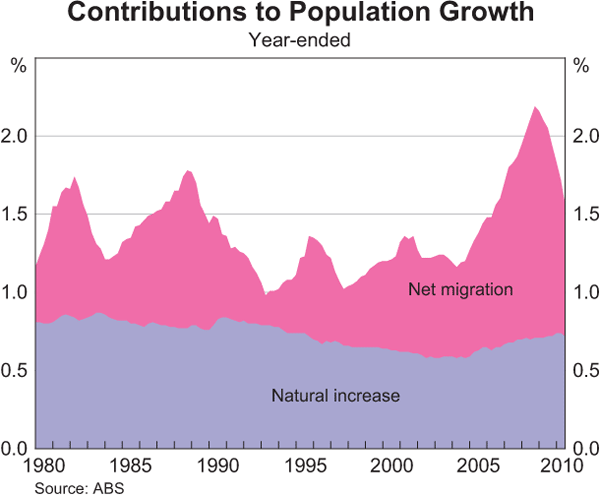
Participation of Females Aged 25 to 54
The rise in female participation is a long-run trend, with each successive cohort of women having a higher participation rate than the previous cohort over the past 40 years (Betts, Connolly and Orsmond 2007). It is also a global phenomenon, with the participation rate of females aged 25 to 54 rising in almost all advanced economies over the past decade, even in the Scandinavian countries where female participation rates were already relatively high (Graph 5). This development reflects changing social norms as well as the influence of economic factors. Higher rates of female educational attainment have boosted employment outcomes – the proportion of females with post-school qualifications increased from 7 per cent in the early 1980s to over 25 per cent in the mid 2000s, to be higher than the share of males with post-school qualifications. The strong growth of employment in service industries has also resulted in more jobs with flexible working arrangements, while access to paid maternity leave and child care has widened.[1]
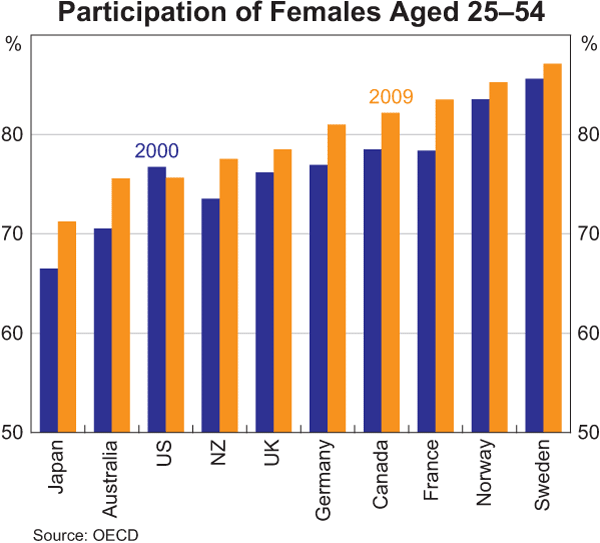
Another factor that is linked to higher rates of female participation over the past 15 years or so is the increase in the debt-servicing costs of home owners. Household indebtedness increased strongly over the 1990s through to the mid 2000s at the same time as female labour force participation rose. The causation in the relationship between debt and participation is likely to run in both directions, with higher labour force participation enabling more borrowing, while higher debt-servicing costs encourage households to work more.[2]
Responses to the HILDA Survey show a clear correlation between housing debt and female labour force participation.[3] Females aged 25 to 54 in households with home loans had a participation rate around 10 percentage points higher than those without home loans in the late 2000s, and this gap has increased since the early 2000s (Table 1). There is also a positive relationship between female participation and debt-servicing costs: women in households with a home-loan-servicing ratio (excluding the female's own labour income[4]) greater than 30 per cent have a participation rate around 10 percentage points higher than those with a lower home-loan-servicing ratio (Graph 6). Furthermore, the share of females in households with home-loan-servicing ratios greater than 30 per cent has increased from around 35 per cent in the early 2000s to around 45 per cent in the late 2000s.
| 2001–2003 | 2007–2009 | |||||
|---|---|---|---|---|---|---|
| Participation rate | ||||||
| – In households with home loans | 77 | 84 | ||||
| – In households without home loans | 69 | 73 | ||||
| Share of females in households with home loans | 49 | 52 | ||||
|
Sources: HILDA Release 9.0; RBA |
||||||
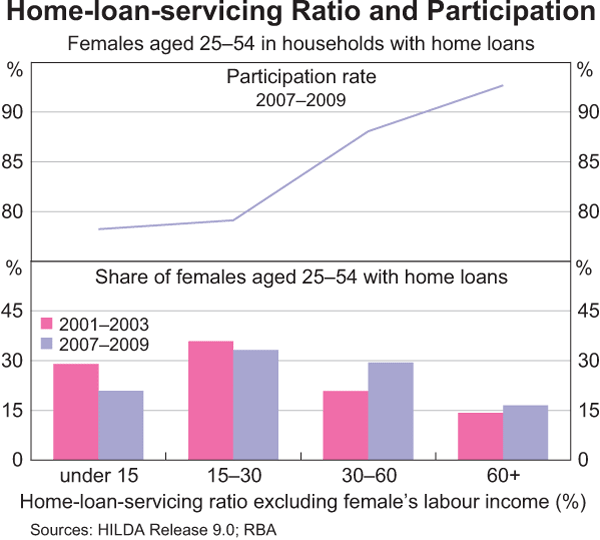
Participation of Persons Aged 55 to 64
The largest increases in participation over the past decade have occurred for persons aged 55 to 64. The trend in the participation rate of this age group is also common to many advanced economies (Graph 7). A number of factors have encouraged workers to remain in the labour force for longer, including: greater longevity; increases in the qualification age for the Age Pension;[5] more flexible work practices, including the increased availability of part-time work; and the rising share of jobs in the services sector, where employment is typically less physically demanding than in traditional goods-producing industries. Consistent with this, persons aged 55 to 64 have experienced strong growth in services employment over the past 10 years, with the number of older women working in education, health and public services rising rapidly (Graph 8). The relative strength of the labour market over recent years has also made it easier for workers to remain in the labour force for longer.
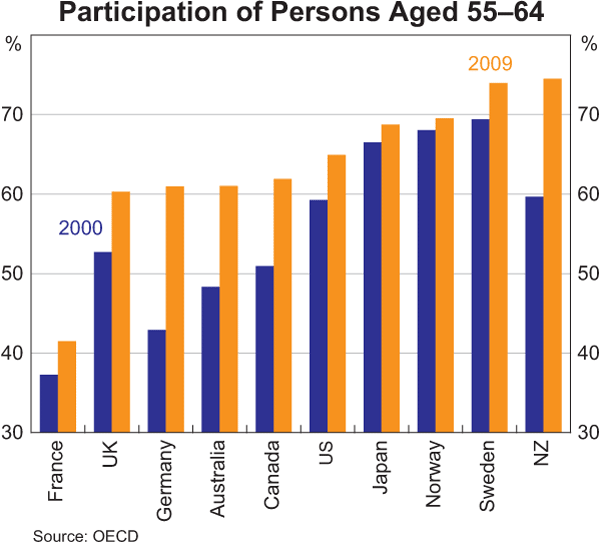
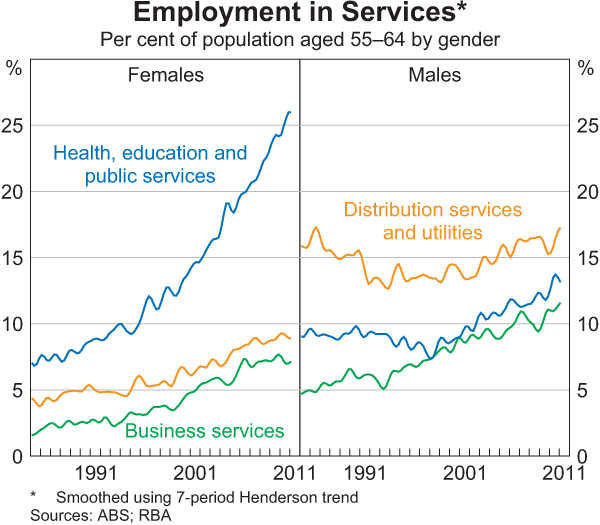
The rise in the participation rate of persons aged 55 to 64 has also been related to developments in household balance sheets. Over the 1990s and 2000s, there has been a trend towards greater indebtedness for these persons, with the proportion in households with owner-occupied home loans rising from around 20 per cent in the early 2000s to around 30 per cent later in the decade (Table 2). Persons aged 55 to 64 with a home loan have a much higher participation rate than those without a home loan: over the 2000s, the gap was around 25 percentage points. These facts are consistent with these workers remaining in the labour force for longer to either pay off existing debts or to borrow against their future income to purchase assets and fund expenditure.
| 2001–2003 | 2007–2009 | |||||
|---|---|---|---|---|---|---|
| Participation rate | ||||||
| – In households with home loans | 71 | 77 | ||||
| – In households without home loans | 46 | 53 | ||||
| Share of persons in households with home loans | 20 | 32 | ||||
|
Sources: HILDA Release 9.0; RBA |
||||||
The period of financial market turmoil in 2008 and 2009 also affected the retirement intentions of older workers, with many experiencing declines in the value of their superannuation assets, reducing their future retirement income. In response, some older workers decided to delay their retirement to rebuild their financial assets. Evidence for this can be found in the HILDA Survey, in which all workers aged 45 and over were asked in 2003, and again since 2006, when they expected to retire. From 2003 to 2007, workers reported a gradual shift towards later retirement (Graph 9). In the 2008 survey, mainly conducted in the second half of the year when the financial market turmoil was particularly acute, the proportion expecting to retire early fell noticeably and uncertainty was relatively high, reflected in an increase in the proportion of respondents who did not know when they would retire. By 2009, this uncertainty had resolved in favour of later retirement, with almost 60 per cent of workers expecting to retire at age 65 or over, up from 50 per cent just two years earlier.
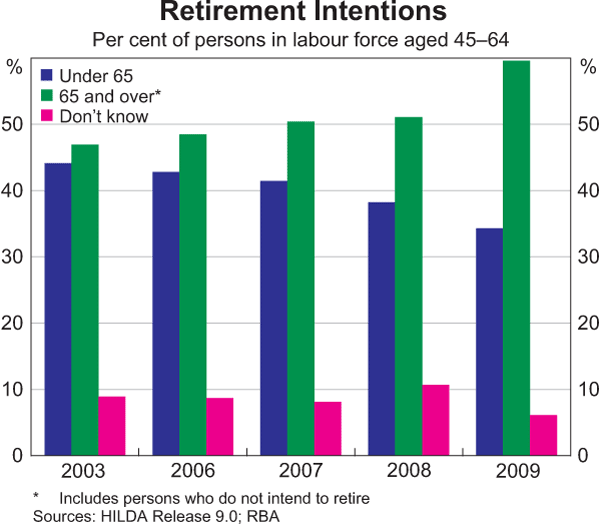
Falling Average Hours Worked
The rise in participation has coincided with a fall in average hours worked, particularly over the past decade. As a result, the total number of hours worked has grown at a slower pace than the number of people employed. The decline in average hours worked has been partly due to the rising participation of women aged 25 to 54 and persons aged 55 to 64; these groups are more likely to work part time (fewer than 35 hours per week), and their share of the labour force has increased from 31 per cent in 1980 to 43 per cent in 2010. However, from 1980 to 2000, this effect was largely offset by a significant increase in the share of persons working long hours (45 or more hours per week; Graph 10). Over the past decade, the share working long hours has declined, particularly for men, accelerating the decline in average hours worked.
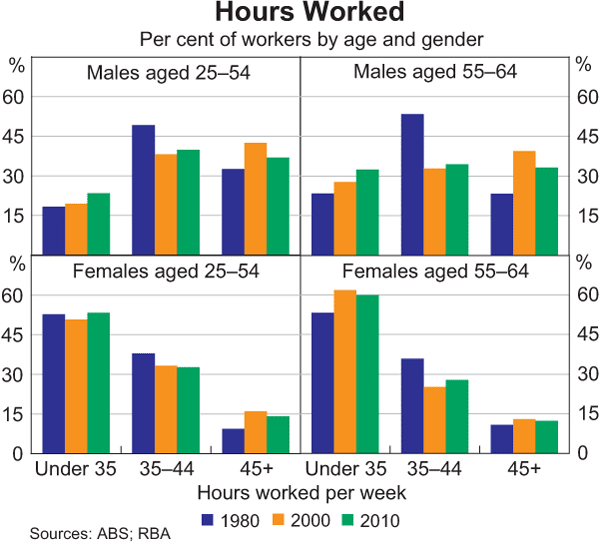
The trend away from working long hours over the past decade is consistent with preferences reported in the HILDA Survey, where workers are asked how many hours they work per week, and the number of hours they would prefer to work. On average, those who work long hours would prefer to work fewer hours (Graph 11). This is particularly the case for workers aged 55 to 64, with the gap between their preferred hours and usual hours widening further over the past decade. So while older workers are intending to retire later, they would also like to reduce the number of hours they are working.
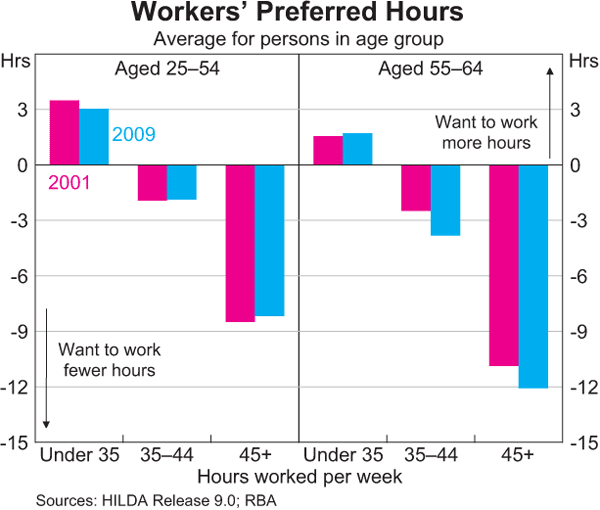
Migration
Immigration contributes to Australia's labour supply by increasing the working age population. It can also raise labour force participation by attracting people who have a higher propensity to work. Over 80 per cent of the migrants that arrived in 2009/10 were of working age, compared to a little under 70 per cent of the total population (Graph 12). Immigration can also improve the job-skills match in the economy by bringing in workers with skills that are in high demand but where local supply is insufficient.
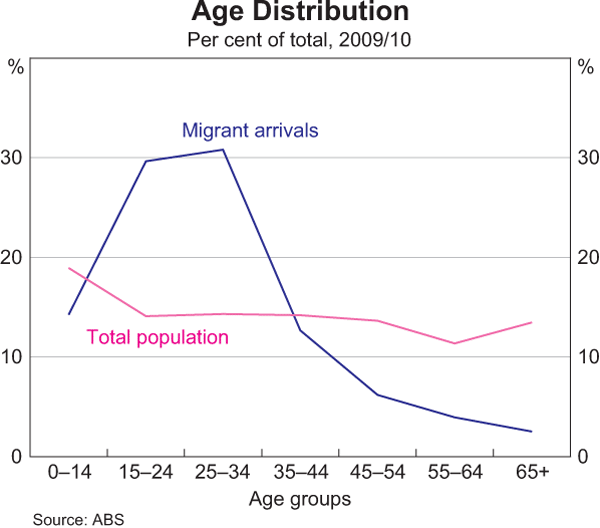
Data from the ABS labour force survey can be used to examine the labour market performance of immigrants in the first few years after their arrival.[6] The proportion of the labour force that had arrived in Australia in the previous five years rose from under 3 per cent in 1996 to almost 6 per cent in 2011 (Graph 13). This has been accompanied by improved employment outcomes for immigrants, and the number of unemployed immigrants as a share of the labour force has declined. The share of recently arrived immigrants working in part-time jobs has also increased over the past two decades, particularly over the past five years, possibly reflecting an increase in the number of foreign students in Australia.
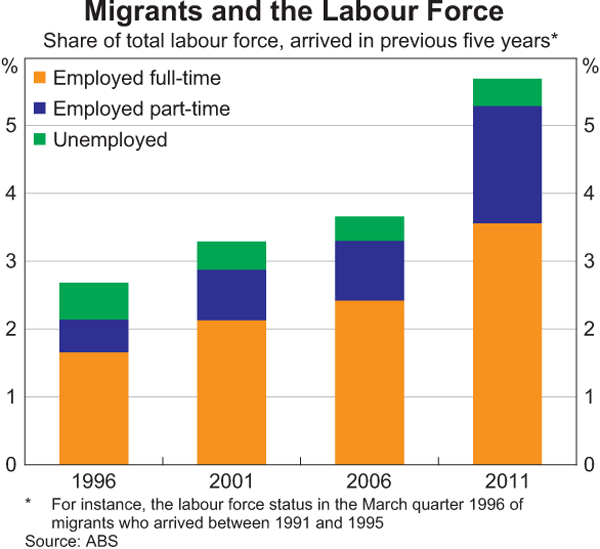
Reflecting their younger age profile, immigrants have a higher participation rate than the general population, and the participation rate for immigrants has increased steadily over the past couple of decades. For instance, in 2011, the participation rate of immigrants that arrived in the previous five years was 70 per cent, higher than the 66 per cent participation rate for the general population, and well above the participation rate for immigrants that arrived in the five years to 2001, which was 61 per cent at the time.[7]
The biggest contribution of immigration to the labour supply has come from changes in the composition of Australia's migration intake. In particular, the increase in permanent visas since the mid 1990s has largely been for skilled migrants, while the number of visas for family reunions has grown more slowly (Graph 14). The labour force participation rate of skilled migrants tends to be significantly higher than for family reunion migrants, and their unemployment rate is noticeably lower (Department of Immigration and Citizenship 2006).
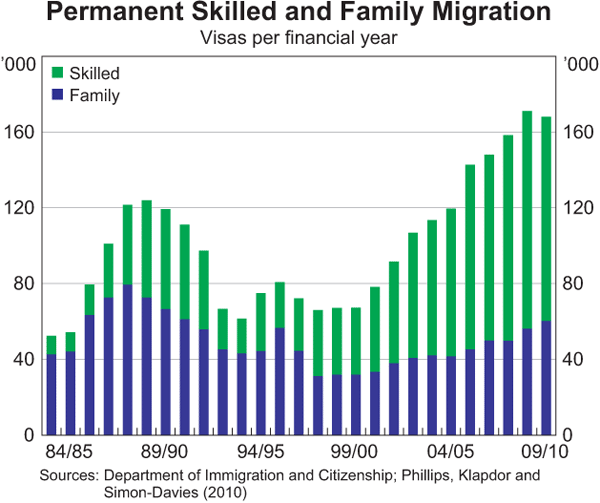
A range of temporary visa holders – temporary skilled workers, students and working holiday-makers – have also added to the labour supply. Temporary skilled working visas, generally known as 457 visas, are employer-sponsored visas limited to specified skilled occupations where domestic labour shortages have been identified. The number of 457 visa holders in Australia has doubled since the mid 2000s (Graph 15). A significant number of 457 visa holders are employed in the business services sector, particularly in firms in the information, media and telecommunications industries (Graph 16). The healthcare and social assistance industries also employ a sizeable share of Australia's 457 visa holders, with a little over a third of this category consisting of medical practitioners and another third comprising registered nurses. Overall, 457 visas are only a small share of total employment, accounting for less than 1 per cent of employment in all industries except mining. Consistent with the higher share of 457 visa holders in the mining industry, 457 visas represent a larger share of the state population in Western Australia and the Northern Territory, where mining jobs are a higher share of employment.
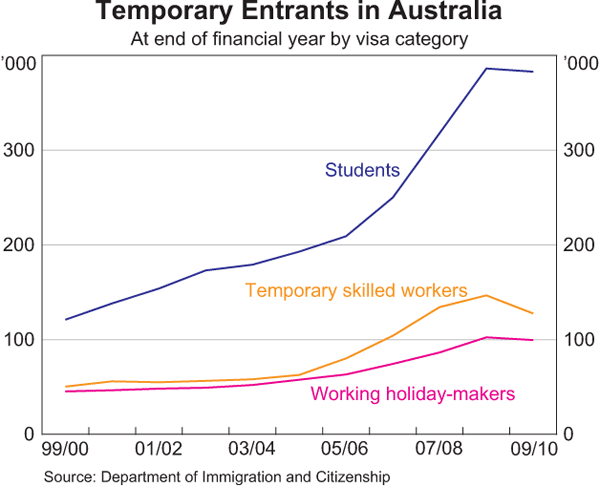
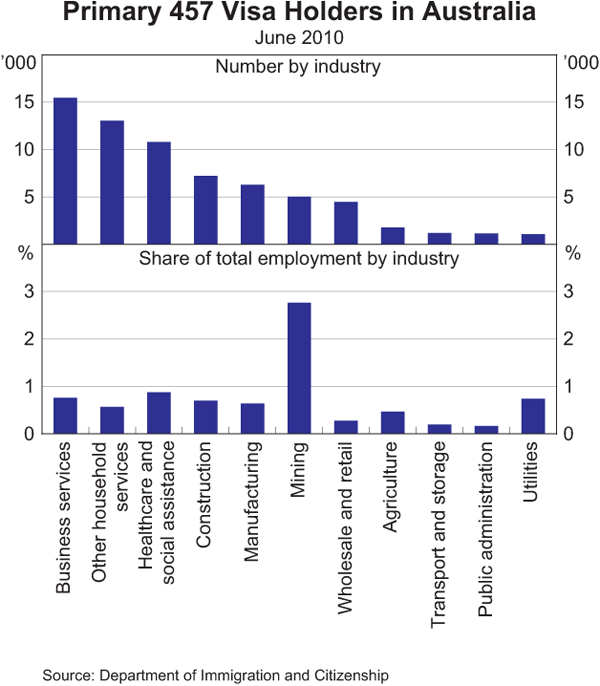
Student visas holders also have the potential to add to the labour supply, as they are permitted to work 20 hours a week while their course is in session and unlimited hours during scheduled course breaks. The number of student visa holders in Australia has tripled over the past decade, by far the largest increase in number of any visa category. A 2010 survey by Universities Australia suggests that in the first half of first semester more than 40 per cent of overseas students had a part-time job; the share is likely to be higher later in the year when commencing students become more established (Varghese and Brett 2011).
Working holiday-makers add to the labour supply for both part-time and full-time jobs. The number of working holiday visa holders in Australia has almost doubled since the mid 2000s, although it remains relatively small compared to the number of temporary skilled workers and students. Working holiday visas also add to the labour supply in regional areas, as holiday-makers can be eligible for a second working visa if they undertake seasonal work in a regional area (such as in the rural or tourism industries).
Conclusion
Over recent decades, strong growth in the demand for labour has been accompanied by a large expansion of the labour force, particularly since the mid 2000s. Labour force growth has reflected increased participation as well as population growth. The increase in participation has been most pronounced for females and older persons, driven by a range of social and economic factors. Higher participation for these groups has also been associated with a decline in average hours worked. The acceleration in population growth has been largely due to higher immigration, with a larger intake of skilled workers and students a major contributor to the rise in the labour supply.
Footnotes
The authors are from Economic Analysis Department. [*]
See Gong, Breunig and King (2010) for evidence on the relationship between child care costs and female labour force participation. [1]
Belkar, Cockerell and Edwards (2007) model the relationship between debt and participation for persons aged 25 to 54, controlling for the two-way causation between debt and labour supply. They concluded that debt-servicing costs were a significant influence on a female's labour force participation decision. Richards (2009) noted that the rise in hours worked by households aged 25 to 39 over several decades was partly related to the rise in house prices, both as cause and effect. [2]
The Household, Income and Labour Dynamics in Australia (HILDA) Survey is a panel study of around 7,500 households conducted annually since 2001. [3]
The home-loan-servicing ratio is defined as home loan repayments relative to gross household income. By excluding the female's own labour income, the home-loan-servicing ratio of a household where the female earns labour income can then be compared with one for a household where the female does not earn labour income on a consistent basis. [4]
The female qualification age has been gradually increasing from 60 to 65 since 1995, to match the male qualification age. The qualification age for both men and women will increase from 65 to 67 between 2017 and 2024, which will further encourage later retirement. [5]
These data on the labour force participation of newly arrived immigrants only include immigrants that are in Australia for more than 12 months. Therefore, some student visa holders and working holiday-makers would not be included. [6]
Participation rates tend to rise over time as immigrants settle into Australia; Hsieh and Kohler (2007) find that immigrants' participation rates are low in the first few months after arrival, but they tend to increase quite rapidly. [7]
References
Belkar R, L Cockerell and R Edwards (2007), ‘Labour Force Participation and Household Debt’, RBA Research Discussion Paper No 2007-05.
Betts T, E Connolly and D Orsmond (2007), ‘Trends in Employment and Labour Supply’, RBA Bulletin, September, pp 1–7.
Department of Immigration and Citizenship (2006), ‘The Labour Market: Summary of Findings for LSIA 3’, The Longitudinal Survey of Immigrants to Australia. Available at: <http://www.immi.gov.au/media/research/lsia3/labour-market.htm>.
Gong X, R Breunig and A King (2010), ‘How Responsive is Female Labour Supply to Child Care Costs – New Australian Estimates’, Treasury Working Paper No 2010–03.
Hsieh W and M Kohler (2007), ‘Immigration and Labour Supply ’, RBA Bulletin, September, pp 8–13.
Phillips J, M Klapdor and J Simon-Davies (2010), ‘Migration to Australia Since Federation: A Guide to the Statistics’, Background Note, Parliamentary Library. Available at: <https://parlinfo.aph.gov.au/parlInfo/download/library/prspub/158143/upload_binary/158143.pdf>.
Richards A (2009), ‘Housing Market Developments’, Address to the CEDA Housing Forum: A National Round-up, Sydney, 29 September.
Varghese M and K Brett (2011), ‘International Student Barometer Project 2010 – National Report’, Commissioned Study, Universities Australia. Available at: <http://www.universitiesaustralia.edu.au/resources/575/817.pdf>.